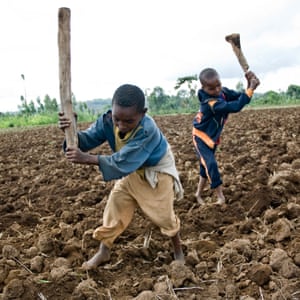A public health campaign has been launched in western Uganda after scientists unexpectedly found the region was afflicted by a tropical disease that causes disfigurement and swelling.
The discovery came to light after experts were dispatched to Kamwenge district to investigate an outbreak of lymphatic filariasis, more commonly known as elephantiasis. A team of specialists from the Ugandan ministry of health, the World Health Organization and the Centers for Disease Control and Prevention was surprised to find that the condition causing limbs to swell was in fact podoconiosis, also known as non-filarial elephantiasis. The disease was previously unknown in the region.
Unlike lymphatic elephantiasis, which is contracted when a parasitic worm is transmitted to humans by mosquitoes, podoconiosis – also known as “mossy foot” because it causes moss-like warts called hyperkeratotic papilloma – is contracted by walking barefoot on irritant volcanic soils. Blood samples taken by scientists from 52 people tested for lymphatic filariasis found no worms present.
Philip Rosenthal, professor of medicine at the University of California, San Francisco, and editor of the American Journal of Tropical Medicine and Hygiene, which published the findings this month, said: “The study was pioneering in discovering that this syndrome was causing serious morbidity in a part of the world where previously we had no idea that podoconiosis existed. The real key is preventing this in future generations.”
Podoconiosis, a progressive, non-infectious disease with symptoms that include itching, foot pain and swelling, can lay undetected for decades, but is treatable.
Dr Christine Kihembo, a senior field epidemiologist with the Ugandan health ministry and the study’s lead author, said many patients had probably been “suffering silently without help for more than 30 years”.
Kihembo said Kamwenge district was forested until the 1960s, when migrants looking for farmland began tilling the soil. Early symptoms of the disease went undetected because it was never documented in western Uganda.
She said patients may not have associated initial symptoms with soil contact, and that “there was a tendency among those affected to stay at home with their disability and not go to a health facility”.
Gail Davey, professor of global health epidemiology at Brighton and Sussex Medical School and founder of the NGO Footwork, said it was unsurprising the disease had gone unnoticed for decades because it is the very poorest areas that are affected.
Podoconiosis affects an estimated 4 million people globally and is found in the highland areas of Africa, Latin America and south-east Asia.
It is caused by an inflammatory reaction to minerals in volcanic soils. On contact, the minerals penetrate the skin, causing severe itching and pain. They are taken up by white blood cells, triggering inflammation that produces a thickening of scar tissue, causing swelling and ulcerated sores in the lower limbs. Typically, both lower limbs are affected. Unlike parasitic elephantiasis, it rarely affects the genitals.
Many people avoid sufferers because they believe the disease to be infectious. Davey said the disease is “highly stigmatised, probably more so than leprosy”, with sufferers often hidden away in communities, where it is seen as a curse.

Sufferers’ inability to work leads to a reduced income, which has a detrimental effect on mental health. Many victims experience depression.
The discovery of podoconiosis in the region has prompted a public health education campaign to highlight the importance of foot hygiene, and Footwork has trained local health workers to treat the condition.
Davey recalls a man she met at a clinic whose marriage ended because the disease left him unable to look after his farm: “He no longer saw his children because they thought it brought shame to the household. For him, just to hear that the condition can be treated was a bit of a light-bulb moment”.
“It is reversible – even the late stages can be improved enormously with careful hygiene and bandaging, and shoes and socks to protect.”
Podoconiosis will be among the neglected tropical diseases discussed at a summit in Geneva this week. Attendees will discuss the development of a global atlas of podoconiosis, which will map the global geography of the disease and inform efforts to eradicate it.
“We believe we can eliminate podoconiosis in our lifetime,” said Wendy Santis, Footwork’s executive director. “We know the cause and how to treat it. Now our most urgent need is for funding so that we can target our efforts to have the greatest impact.”
Health push in Uganda after mystery disease turns out to be "mossy foot"
Hiç yorum yok:
Yorum Gönder